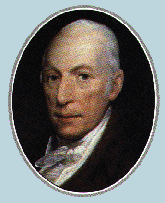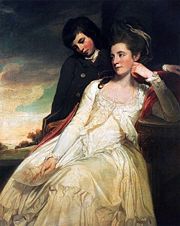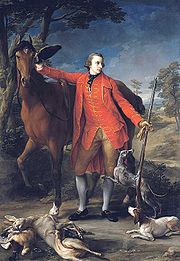
Alexander Gordon, 4th Duke of Gordon
Encyclopedia

Order of the Thistle
The Most Ancient and Most Noble Order of the Thistle is an order of chivalry associated with Scotland. The current version of the Order was founded in 1687 by King James VII of Scotland who asserted that he was reviving an earlier Order...
(18 June 1743 – 17 June 1827), styled Marquess of Huntly until 1752, was a Scottish
Scotland
Scotland is a country that is part of the United Kingdom. Occupying the northern third of the island of Great Britain, it shares a border with England to the south and is bounded by the North Sea to the east, the Atlantic Ocean to the north and west, and the North Channel and Irish Sea to the...
nobleman, described by Kaimes as the "greatest subject in Britain", and was also known as the Cock o' the North
Cock o' the North
Cock o' the North may refer to;*Alexander Gordon, 4th Duke of Gordon was known by the nickname Cock o' the North*The Chief of Clan Gordon is known as the Cock o' the North of Coileach Strath Bhalgaidh in Scottish Gaelic...
, the traditional epithet attached to the chief of the Gordon clan
Clan Gordon
Clan Gordon, also known as the House of Gordon, is a Scottish clan. The chief of the clan was the powerful Earl of Huntly, now also Marquess of Huntly.-Origins:...
.
Early life
Alexander Gordon was born at Gordon CastleGordon Castle
Gordon Castle is located in Gight, near Fochabers in Moray, Scotland. Historically known as the Bog-of-Gight, it was the principal seat of the Dukes of Gordon...
, Fochabers
Fochabers
Fochabers is a village in the Parish of Bellie, in Moray, Scotland, not far from the cathedral city of Elgin and located on the east bank of the River Spey. Around 2,000 people live in the village, which enjoys a rich musical and cultural history...
, on 18 June 1743, the eldest son of Cosmo Gordon, 3rd Duke of Gordon
Cosmo Gordon, 3rd Duke of Gordon
Cosmo George Gordon, 3rd Duke of Gordon KT , styled Marquess of Huntly until 1728, was a Scottish peer....
and his wife, Lady Catherine Gordon, daughter of the 2nd Earl of Aberdeen
William Gordon, 2nd Earl of Aberdeen
William Gordon, 2nd Earl of Aberdeen , known between c. 1691 and 1720 as Lord Haddo, was a Scottish peer, Tory politician and Jacobite....
. He was educated at Eton
Eton College
Eton College, often referred to simply as Eton, is a British independent school for boys aged 13 to 18. It was founded in 1440 by King Henry VI as "The King's College of Our Lady of Eton besides Wyndsor"....
and also possibly at Harrow
Harrow School
Harrow School, commonly known simply as "Harrow", is an English independent school for boys situated in the town of Harrow, in north-west London.. The school is of worldwide renown. There is some evidence that there has been a school on the site since 1243 but the Harrow School we know today was...
. He succeeded as 4th Duke of Gordon in 1752. His younger brother was Lord George Gordon
Lord George Gordon
Lord George Gordon was a British politician best known for lending his name to the Gordon Riots of 1780....
who led the Gordon Riots
Gordon Riots
The Gordon Riots of 1780 were an anti-Catholic protest against the Papists Act 1778.The Popery Act 1698 had imposed a number of penalties and disabilities on Roman Catholics in England; the 1778 act eliminated some of these. An initial peaceful protest led on to widespread rioting and looting and...
.
He was elected as a Scottish representative peer
Representative peer
In the United Kingdom, representative peers were those peers elected by the members of the Peerage of Scotland and the Peerage of Ireland to sit in the British House of Lords...
from 1767. He was appointed a Knight of the Thistle
Order of the Thistle
The Most Ancient and Most Noble Order of the Thistle is an order of chivalry associated with Scotland. The current version of the Order was founded in 1687 by King James VII of Scotland who asserted that he was reviving an earlier Order...
in 1775 and was created a Peer of Great Britain
Peerage of Great Britain
The Peerage of Great Britain comprises all extant peerages created in the Kingdom of Great Britain after the Act of Union 1707 but before the Act of Union 1800...
as Baron Gordon of Huntley, of Huntley
Huntley, Gloucestershire
Huntley, Gloucestershire, is a village on the A40 located seven miles west ofGloucester in the north of the Forest of Dean.- History :Huntley is mentioned in the Domesday Book as Huntelei....
in the County of Gloucester
Gloucestershire
Gloucestershire is a county in South West England. The county comprises part of the Cotswold Hills, part of the flat fertile valley of the River Severn, and the entire Forest of Dean....
, and Earl of Norwich, in the County of Norfolk
Norfolk
Norfolk is a low-lying county in the East of England. It has borders with Lincolnshire to the west, Cambridgeshire to the west and southwest and Suffolk to the south. Its northern and eastern boundaries are the North Sea coast and to the north-west the county is bordered by The Wash. The county...
, in 1784. His new titles were not universally popular. He was thought to have taken designations to which he had no right. The Scots Peerage described the Gordon of Huntley peerage thus: "an absurd specimen of Peerage topography. The village of Huntley, four miles from Newent in Gloucestershire, had apparently no connection with the Gordon family or with the town of Huntly in North Britain." While George Edward Cokayne in The Complete Peerage
The Complete Peerage
The Complete Peerage The Complete Peerage The Complete Peerage (full title: The Complete Peerage of England, Scotland, Ireland, Great Britain, and the United Kingdom Extant, Extinct, or Dormant; first edition by George Edward Cokayne, Clarenceux King of Arms; 2nd edition revised by the Hon...
says the following with regard to the Duke's choice of Norwich for his Earldom: "His great-grandmother was the daughter of the 5th Duke of Norfolk and 1st Earl of Norwich, but though that title had become extinct in 1777, the representation thereof did not vest in the issue of that lady."
He was Keeper of the Great Seal of Scotland from 1794 to 1806 and from 1807 to 1827. Between 1793 and 1827, he was Chancellor of King's College, Aberdeen. In addition, he was Lord Lieutenant of Aberdeenshire until 1808. He received the Order of the Thistle
Order of the Thistle
The Most Ancient and Most Noble Order of the Thistle is an order of chivalry associated with Scotland. The current version of the Order was founded in 1687 by King James VII of Scotland who asserted that he was reviving an earlier Order...
from King George III on 11 January 1775. The Duke was a truly enlightened grandee. He planned villages, improved his estates and was well regarded by his tenants. The Dictionary of National Biography
Dictionary of National Biography
The Dictionary of National Biography is a standard work of reference on notable figures from British history, published from 1885...
described him thus: "At the time of his marriage the Duke was reputed one of the handsomest men of his day."
He raised regiments (the 92nd Highlanders
The Gordon Highlanders
The Gordon Highlanders was a British Army infantry regiment from 1794 until 1994. The regiment took its name from the Clan Gordon and recruited principally from Aberdeen and the North-East of Scotland.-History:...
) in 1794 for the French Revolutionary Wars
French Revolutionary Wars
The French Revolutionary Wars were a series of major conflicts, from 1792 until 1802, fought between the French Revolutionary government and several European states...
. He was responsible for establishing the village of the new village of Fochabers
Fochabers
Fochabers is a village in the Parish of Bellie, in Moray, Scotland, not far from the cathedral city of Elgin and located on the east bank of the River Spey. Around 2,000 people live in the village, which enjoys a rich musical and cultural history...
as well as for Tomintoul
Tomintoul
Tomintoul is a village in the Moray council area of Scotland; until 1975 it was located in the county of Banffshire.It is said to be the highest village in the Scottish Highlands, but at is still significantly lower than the highest village in Scotland .The village was laid out on a grid pattern...
and Port Gordon in Banffshire
Banffshire
The County of Banff is a registration county for property, and Banffshire is a Lieutenancy area of Scotland.The County of Banff, also known as Banffshire, was a local government county of Scotland with its own county council between 1890 and 1975. The county town was Banff although the largest...
. He is also credited as the founder of the Gordon Setter
Gordon Setter
A Gordon Setter is a large breed of dog, a member of the setter family that also includes both the better-known Irish Setter and the English Setter. Setter breeds are classified as members of either the Sporting or Gundog Group depending on the national kennel club or council. The original purpose...
breed of dog, having popularised a 200-year-old breed during the 18th century and then formalised its breed standard in 1820.
He was an enthusiastic supporter and patron of the music of William Marshall
William Marshall (Scottish composer)
William Marshall is regarded as one of the greatest composers of Scottish fiddle music.Marshall was born in Fochabers, Scotland. He entered the service of the Duke of Gordon, eventually becoming the Factor to the Gordon Estate. James Hunter's The Fiddle Music of Scotland credits Marshall with...
(1748–1833), a Scottish fiddler and composer, and famous for his many strathspeys, who acted as steward of the Gordon household.
Marriage and family

Jane Gordon, Duchess of Gordon
Jane Gordon, Duchess of Gordon was a significant Scottish Tory political hostess.-Life:The wife of Alexander Gordon, 4th Duke of Gordon, she was second daughter of Sir William Maxwell, third baronet of Monreith, Wigtownshire, by his wife Magdalen Blair of Blair. She was born in Hyndford's Close,...
, the daughter of Sir William Maxwell, 3rd Baronet of Monreith, by his wife, Magdalen, daughter of William Blair, of Blair, Ayrshire. Duchess Jane was born at Hyndford's Close, Edinburgh in 1748, she was described by the diarist Sir Nathaniel Wraxall, as a celebrated beauty. From 1787 she was the social centre of the Tory party and was described in the Female Jockey Club of 1794, as possessing "an open ruddy countenance, quick in repartée, and no one excelling her in performing the honours of the table, her society is generally courted". It went on to say that
"The Duchess triumphs in a manly mien;
Loud is her accent, and her phrase obscene."
She resided for some years in Edinburgh, but eventually refused to renew her residence at George Square, Edinburgh, because it was "a vile dull place".
The poet Erskine wrote the following lines to her;-
"That is, quoth he, as if the Sun should say,
A vile dark morning this - I will not rise to-day."
The Duke and Duchess's marriage was tempestuous from the start and neither made any particular effort to be faithful to the other. For some years before her death she was bitterly estranged from the Duke. While the Duchess resided in the centres of society, the Duke lived in retirement at Gordon Castle. Elizabeth Grant mentions "The great width of the Spey, the bridge at Fochabers, and the peep of the towers of Gordon Castle from amongst the cluster of trees that concealed the rest of the building....the Duke lived very disreputably in this solitude, for he was very little noticed, and, I believe, preferred seclusion."
The Duchess is best remembered for placing the King's shilling between her teeth to help recruitment to the Gordon Highlanders which were founded by her son. However, she also possessed a capacity for match-making which was unrivalled. Of her five daughters, three were married to Dukes, (Richmond, Manchester and Bedford) and one to a Marquess (Cornwallis).

Charles Lennox, 4th Duke of Richmond
Charles Lennox, 4th Duke of Richmond, 4th Duke of Lennox KG, PC was a British soldier and politician and Governor General of British North America.-Background:...
. Charlotte was hostess of the Duchess of Richmond's Ball
Duchess of Richmond's ball
The Duchess of Richmond's ball was held in Brussels on 15 June 1815, the night before the Battle of Quatre Bras. The Duchess's husband Charles Lennox, 4th Duke of Richmond was in command of a reserve force in Brussels, which was protecting that city in case Napoleon Bonaparte invaded.Elizabeth...
—"the most famous ball in history"—held on the eve of the Battle of Quatre Bras
Battle of Quatre Bras
The Battle of Quatre Bras, between Wellington's Anglo-Dutch army and the left wing of the Armée du Nord under Marshal Michel Ney, was fought near the strategic crossroads of Quatre Bras on 16 June 1815.- Prelude :...
, the precursor to the Battle of Waterloo
Battle of Waterloo
The Battle of Waterloo was fought on Sunday 18 June 1815 near Waterloo in present-day Belgium, then part of the United Kingdom of the Netherlands...
. Their son eventually inherited all of the vast estates of the Gordon family. The second daughter, Madelaine, married firstly Sir Robert Sinclair, Bart who died in August 1795 and then married Charles Fysche Palmer, of Luckley Park, Berkshire. The third daughter, Susan (b 2 February 1774) married at Mr Fordyce's house, near Edinburgh, on 7 October 1793, William Montagu, 5th Duke of Manchester
William Montagu, 5th Duke of Manchester
Colonel William Montagu, 5th Duke of Manchester , styled Viscount Mandeville until 1783, was a British peer, soldier, colonial administrator and politician.-Background and education:...
. Elizabeth Grant of Rothiemurchas in her Memoirs of a Highland Lady noted in 1812 that "the Duchess [of Manchester] had left home years before with one of her footmen" while Lady Jerningham wrote in September 1813, that "The Duchess of Manchester is finally parted from her husband, her conduct being most notoriously bad". The Duchess of Manchester died at Bedfont Lodge, on 26 August 1828. The next daughter, Louisa, married at her father's house in Piccadilly in 1797 Charles Cornwallis, subsequently 2nd Marquess Cornwallis. Allegedly, the Marquess had "expressed to the Duchess of Gordon some hesitation about marrying her daughter on account of the supposed insanity in the Gordon family, he received from the Duchess the gratifying assurance that there was not a drop of Gordon blood in Louisa." The youngest daughter, Georgiana, was born at Gordon Castle, on 18 July 1781. She married at Fife House, in 1803, John Russell, 6th Duke of Bedford
John Russell, 6th Duke of Bedford
John Russell, 6th Duke of Bedford KG, PC, LLD, FSA , known as Lord John Russell until 1802, was a British Whig politician and notably served as Lord Lieutenant of Ireland in the Ministry of All the Talents...
as his second wife.
The Duchess of Gordon died at Pulteney's Hotel, Piccadilly, Middlesex, on 14 April 1812 and was buried at her beloved Kinrara near Aviemore. Her husband, the 4th Duke, married secondly, at the Kirk of Fochabers, (probably Bellie), in July 1820, Jane [or Jean] Christie, who was a native of Fochabers and was then aged about 40. The Duke had previously had four natural children by Jane Christie. After their marriage she lived in great style not at the Castle but at a town house in Fochabers. She claimed that by residing at the Castle, which the Duke had rebuilt and enlarged considerably, none of his friends would visit him.
One of the Duke's illegitimate sons, Colonel Charles Gordon, was given the property of Glasterim near Port Gordon. Curiously, Colonel Gordon had been a great favourite with the late Duchess. Elizabeth Grant described Colonel Gordon as "much beloved by Lord Huntly, whom he exceedingly resembled, and so might have done better for himself and all belonging to him, had not the Gordon brains been of the lightest with him."
His second duchess died on 17 June 1824 while the Duke died suddenly at Mount Street, Berkeley Square, on 17 June 1827 (three years to the day after his second wife's death), and was buried in Elgin Cathedral. He was succeeded by his son George Gordon, 5th Duke of Gordon
George Gordon, 5th Duke of Gordon
George Gordon, 5th Duke of Gordon GCB, PC , styled Marquess of Huntly until 1827, was a Scottish nobleman, soldier and politician and the last of his illustrious line.-Early life:...
.

